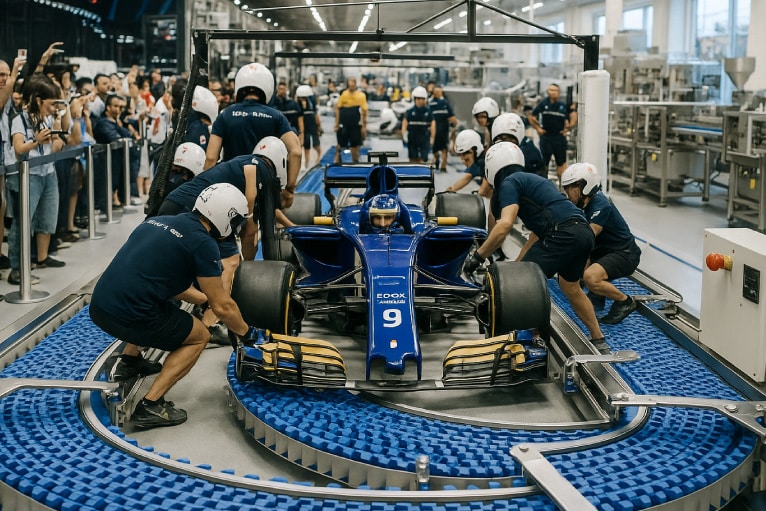
When it comes to packaging line performance, most manufacturers focus on major disruptions, breakdowns, unplanned downtime or machine faults that halt production entirely. But often the biggest hidden losses come from the smallest interruptions: micro-stops in packaging lines.
These brief, recurring pauses, sometimes just a few second, may fly under the radar, but across a shift or week they can cost hours of lost productivity. The impact on OEE (Overall Equipment Effectiveness) is significant: even minor stoppages can drag down availability and performance, without any single event standing out in production reports.
So, what actually causes micro-stops in packaging lines and more importantly, how can you prevent them?
Misaligned Sensors & Why They Trigger Micro-Stops in Packaging Lines
In modern automated packaging lines, sensors are the eyes and ears of the system. They trigger actions, detect product presence, and help machines stay synchronised. When a sensor becomes dirty, misaligned or overly sensitive, it can cause those split-second interruptions we call micro-stops.
For example:
- A photocell failing to detect a clear bottle or label
- A proximity sensor triggering too early or too late
- Light interference from LED lighting or reflections
- Sensors knocked out of position during changeovers
Each false signal may only stop a conveyor for a second or two, but when repeated hundreds of times they add up into measurable downtime. That’s why alignment, cleaning and calibration of sensors should form part of your preventive maintenance programme. It also ties into the regulatory expectation from HSE that equipment is maintained in an “efficient state” and “in efficient order and in good repair”.
For regulatory context and machinery safety in the UK manufacturing sector, see guidance from the Health and Safety Executive (HSE).
Product Jams or Poor Feeding
Feeding systems and conveyors are another common hotspot for micro-stops. On high-speed lines, especially handling lightweight containers or trays, even a momentary jam or poor feeding can cause the line to pause.
Frequent culprits include:
- Incorrect product spacing or orientation
- Overflow at accumulation tables
- Slippage on inclined conveyors
- Blocked feed chutes or over-filled hoppers
Even if the jam resolves itself quickly, the machine rhythm has been lost, and recovery may take longer than the stop itself. Preventative actions: ensure guide rails, feeders and accumulation systems are correctly adjusted for each SKU, and refine your setup processes to avoid these feed-based interruptions.
Cap or Label Misapplication and Micro-Stops in Packaging Lines
Misapplied caps or labels might appear to be purely a quality issue, but they often translate directly into micro-stops downstream. A vision system rejects a bottle, or a capping head senses abnormal torque—each triggers a stop or pause until the system resets or retries.
Root causes may include:
- Temperature or humidity influencing label adhesive tack
- Worn rollers or blades in labellers
- Torque variation or mis-alignment in capping heads
- Container height or diameter inconsistencies
These events may each last only moments, but occur frequently on fast-running lines. Consistent maintenance, setup verification and tracking changeovers properly will mean fewer stops and more stable throughput.Operator Interventions: The Unseen Cause of Micro-Stops in Packaging Lines
Operator Interventions and Human Factors
Even heavily automated lines still rely on people. Manual checks, adjustments and temporary pauses for safety or quality control all count as micro-stops. While essential, frequent operator interventions are often a symptom of deeper issues—slow machine settings, inconsistent setups, lack of operator training or poor visibility of key performance metrics.
Examples include:
- Operators slowing the line to observe a suspected fault
- Pausing conveyors to clear mis-fed products
- Adjusting speeds to match upstream delays
- Stopping for quick fill-level or label alignment checks
Empowering operators with clear dashboards, alarms and fault logs reduces the need for unnecessary interventions, and helps turn interruptions into actionable data for improvement.
The Hidden Cost of Micro-Stops in Packaging Lines
Unlike full breakdowns, micro-stops rarely trigger maintenance call-outs or show up as major downtime events. Yet their cumulative effect can be dramatic—losses of 3–8% of total available production time are not uncommon. Because they are often un-reported, they become hidden drags on performance and efficiency. Visualising the data, conducting root-cause investigations and targeting recurring patterns can reduce these losses significantly.
Reducing Micro-Stops in Packaging Lines with Packserve
At Packserve Limited, we specialise in identifying the root causes of micro-stops and helping manufacturers improve uptime and line performance. Our engineering team supports all major packaging technologies—filling, capping, labelling, conveying and end-of-line systems, delivering targeted solutions that others may miss.
Whether it’s fine-tuning sensor alignment, redesigning feed systems or implementing real-time monitoring dashboards, small changes often deliver big results. To start the process, visit our contact page at Packserve contact and talk to our expert team.
Final Thoughts
Micro-stops might be small, but their impact on productivity is anything but. The good news? They’re highly preventable with the right visibility, maintenance discipline and operator awareness. By focusing on sensor alignment, product flow, consistent setup and empowered operators, your packaging line can run smoother, faster and more efficiently, one micro-stop at a time.
📞 +44 (0) 1254 760 123
📧 info@packserve.co.uk